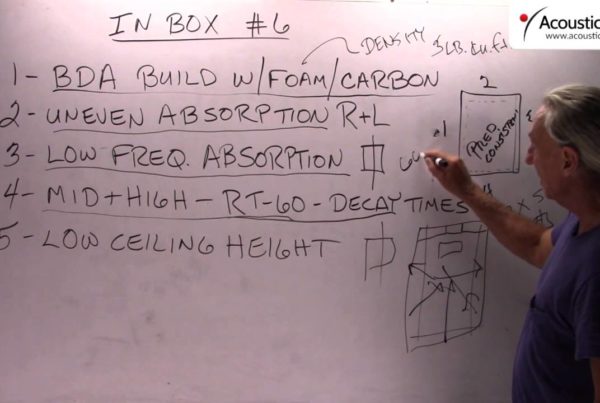Hi All,
Back with another Wednesday Mailbag. This week it’s from Glen in Buffalo asking how to hang up acoustic foam:
Hi Mike,
I’m about to start work on a new studio space and want to get the Acoustic foam in place early. What’s the best way to mount and hang it to give the best results? The walls are cylinder blocks btw.
Thanks
Glen
————
Hi Glen,
Acoustic foams achieve their maximum absorption rates and levels by allowing air to be available to both sides of the foam. This is not an easy task, so you don’t see it done often in companies foam product line products. Remember, there are open celled and closed cell acoustic foams. Make sure you have selected the proper type with the necessary rates and levels of absorption to achieve the specific goals for your studio. Closed celled foams have a smoother absorption curve with less peaks and valleys. Always use closed cell foams for vocal and drum rooms.
Since your new studio space is going to be a blend of science and your art, you want your foam in a manner that will allow you to hang it up if you will for a awhile and then be able to move it around as time and acoustical knowledge increases about the inherit acoustical issues present in your new control room. You will learn more and hear more each day with different source material. The most inexpensive way is to mount the foam to a 1/4″ thick piece of hardboard and then install the hardboard on the wall or ceiling. Make the foam and the hardboard the same size, so you can more easily deal with the cosmetics when you finally decide where it will all go on a permanent basis.
The following videos made by our Chief Acoustics Engineer, Dennis Foley, explain more about closed cell foam, how to hang it and where to position it in your room.
You can build an individual box for the foam and install an acoustically transparent fabric across the face. You can attach it to the wall with a picture hanging wire. You can also expand on this idea and frame around a large surface area and stretch the fabric across the whole framed area. Whatever method you choose, make sure your fabric is acoustically transparent and you do not squish the foam.
Cheers,
Mike
————
So I hope that helps you. If you have any questions at any time I am always on hand to help answer them. Leave them in the comments section or email me at info@acousticfields.com. If you would like to learn more about room acoustics please sign up for my free videos and ebook by joining the mailing list here. I send room tuning tips and things for you to test in your room every Wednesday. They are easy to follow and really help you enjoy more of your music. And if you would like your room acoustic issues analysed for free by Dennis then please fill in the form here and he will be happy to take a look for you.







